Summer Streamflow & Fishing Forecast for Early April, 2024
Posted on April 1st, 2024
Winter 2023-2024 has been warm and dry in Yellowstone Country, just like it has just about everywhere except California through Colorado. For a while we were flirting with record-low snowpack, and 50 degree days have been more common than below-zero here in Livingston. At the end of January we were expecting dire summer water (and fire) conditions. While February and March have generally been wet, and not as warm relative to average, we still anticipate a light runoff that ends early, followed by low water and difficult conditions in late summer. Cross your fingers for a late runoff and wet spring and early summer.
The above is basically the same as our previous update. That’s because things haven’t changed much. They have improved slightly, however.
Read More…
Summer Streamflow & Fishing Forecast for Mid-March, 2024
Posted on March 13th, 2024
Winter 2023-2024 has been warm and dry in Yellowstone Country, just like it has just about everywhere except California through Colorado. For a while we were flirting with record-low snowpack, and 50 degree days have been more common than below-zero here in Livingston. At the end of January we were expecting dire summer water (and fire) conditions. While February and early March have generally been wet, and not as warm relative to average, we still anticipate a light runoff that ends early, followed by low water and difficult conditions in late summer. Cross your fingers for a late runoff and wet spring and early summer.
Note that the maps we used to include on these posts are no longer produced. Instead, find them here: NWCC Maps.
Early 2024 Streamflow and Fishing Conditions Forecast
Posted on January 22nd, 2024
Greetings to clients old and new.
I’m putting up this post to help all of you plan your summer fishing trips to the Yellowstone area, or really Montana in general.
Simply put, it’s looking like all of Montana is in for an extremely low snowpack and resulting low streamflows. This is going to shift the timing for good fishing much earlier in the summer than normal, and it’ll probably make for very poor late summer conditions. These conditions will probably include lots of closures and lots of fires.
That bombshell dropped, I’ll also note that all photos on this page are from the 2023 season, which was pretty productive overall.
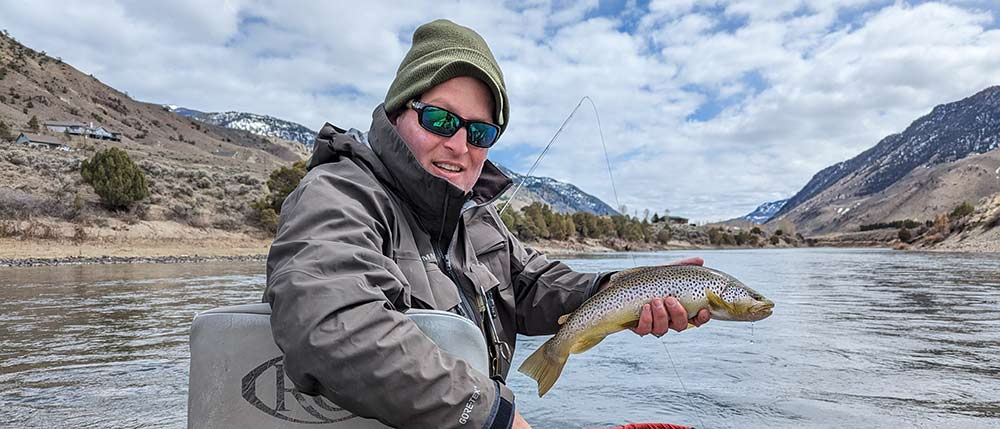
April is usually more a rainbow game (and I did catch a lot more rainbows and browns on this fun float with a buddy), but every once in a while a big brown will smoke a streamer as this one did.
Snowpack and Weather Outlooks
Long story short, we’ve had about a month worth of “actual winter” here in Livingston and in the Yellowstone area, and a week of that occurred in October. We had our largest snow storm of the year in the last week of October, as well as temperatures below zero. It didn’t get below zero again here until ten days ago. That cold (and wet) snap is now passing and it’s going to be in the 40s–50s here in Livingston for the next few days.
The warm, dry late autumn and start to winter leave us with extremely low snowpack across Montana. We’re actually doing better here in the Livingston-Bozeman-Yellowstone area than elsewhere in Montana. We currently have snowpack ranging from 59% to 63% of normal for the date in our core operations area. Points further northwest are lower. The Upper Clark’s Fork Basin is at a record-low 48% of normal, for example.
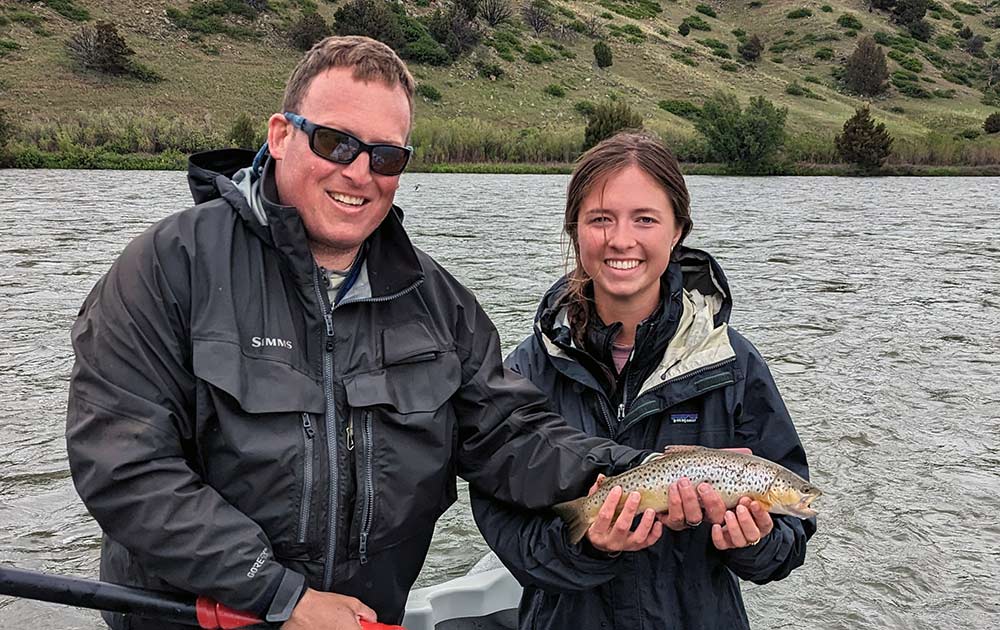
The Lower Madison fished well in late May and June. This might have been her first trout.
Current outlooks for the short (through January), medium (through February), and long term (through spring) are calling for continued warm and dry conditions, unfortunately.
All in all, it seems likely that we are likely to end up with half to two thirds our normal snowpack for the year. For comparison, we love to see around 110% of normal, and anything below 80% can make for tough late-summer conditions.
General Effects on Summer Fishing Streamflows and Fishing
If the above conditions come through as we unfortunately expect, we anticipate profound impacts on summer fishing. These are:
- Short and Limited Spring Runoff: Many waters such as the Madison and Boulder Rivers are unlikely to become unfishably muddy. Even the Yellowstone River (particularly in Yellowstone Park near Tower Falls) may only experience brief shots of dirty water.
- An Early End to Runoff: At the moment, we expect runoff to end no later than June 25 on all waters, even places like the Lamar which are seldom ready before July 4.
- Exceptional Fishing in Late June and Early July: While low-water years generally see tougher fishing in late summer, they usually see far better than average fishing in late June and early July. Our most recent year with conditions like we now expect for 2024 was 2021. June 20 through July 10, 2021 offered the best dry-dropper fishing we’ve ever seen on the Yellowstone River. We basically had a Salmonfly hatch and very early hopper fishing without having to cast into the bushes.
- Extreme Low Water in Late Summer: absent a very slow melt and abundant summer rain, it seems likely we’ll be looking at record-low or near record-low streamflows in late summer.
- Difficult Late Summer and Early Fall Fishing: Late summer and September 2021 offered the worst fishing we’ve ever had on the Yellowstone River. We’re talking about a handful of trout and whitefish on tiny nymphs, and not much else. The worst fishing will occur in early-mid August. Late August and September fishing will depend on light levels. Clouds mean solid fishing. Bright sun means tough fishing.
- Widespread Afternoon and Evening Fishing Restrictions: Because of the low flows, it seems almost certain we’ll have widespread 2PM to midnight “hoot owl” fishing closures throughout our operations area due to warm water, including on rivers like the Yellowstone where they are seldom necessary to protect the trout. These closures are most likely from July 25 through August 20. They could begin earlier and end later depending on the progress of the spring melt and summer heat.
- Widespread Fires and Extreme Fire Restrictions: In 2021, you could not smoke a cigarette unless standing on asphalt or in a river. We expect similar conditions this year. We also expect a lot of smoke, since most of the northwest and Canada is in as bad or worse shape than we are. The smoke actually helps water temps and fishing, since it functions like an overcast.
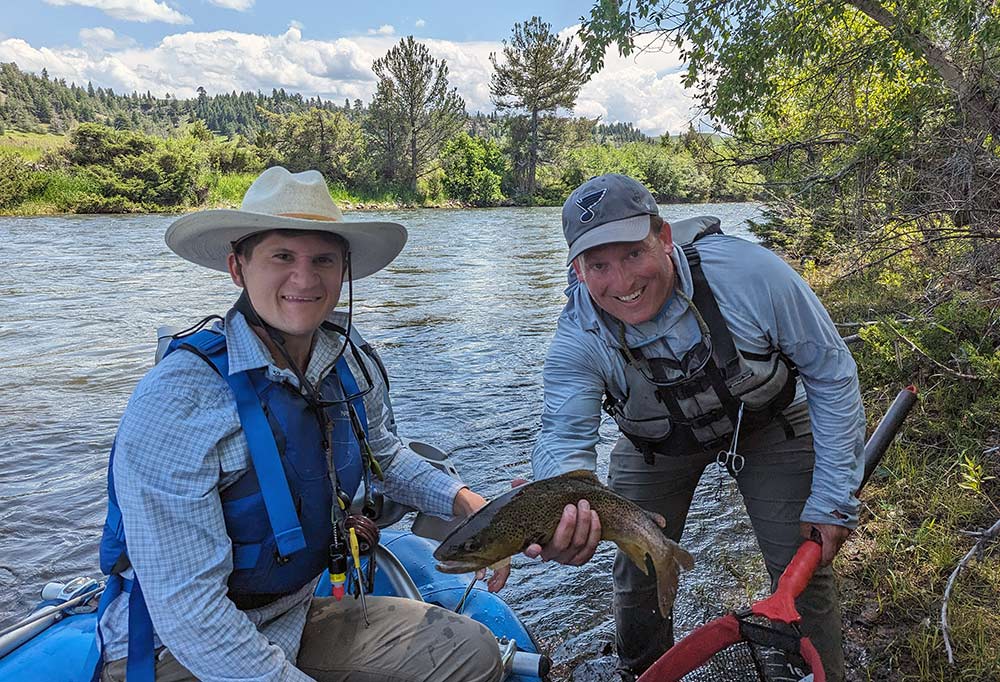
The Boulder River is only high enough to float for a short window, but it is probably our favorite river nowadays for about three weeks in late June and early July.
So What Do We Suggest?
This is not all doom and gloom, but it’s kind of doom and gloom. To work around likely poor conditions in late summer and early fall, we suggest the following if at all possible:
- Come Much Earlier in the Season, if Possible. See the “best fishing” info under the next heading for suggested target dates.
- If You Come in August or September, Please be Flexible. We are going to want to start early, fish rough or shady water, chase carp, and otherwise try to work around the low, warm water we expect to see. This will be especially important in August, but bright, hot, sunny days will see spooky and grumpy trout in September, too. The water will be plenty cold, but too low for them to be aggressive without cloud cover.
- Consider Coming in October: October fishing is awesome around here, and summer water conditions don’t really impact it. If you haven’t experienced the low crowds, BWO hatches, fall-run brown trout, and epic private lake fishing we often see in October, this is a good year to aim for it.
I’ll note here that waters near Missoula and especially near Glacier NP might actually be in worse shape and have earlier peaks and more restrictions than we will. The Glacier area is already in a prolonged drought, whereas our soil moisture is actually still good in the Yellowstone area.

This wasn’t a great big fish year on the Yellowstone, but this kid lucked into a nice one on his first day fly fishing.
End of Runoff and Expected Best Periods
Assuming continued drought conditions and a roughly-normal start date for the spring melt, here are our predictions for an ending date for the spring melt (signifying a start to summer fishing) and expected best fishing dates overall.
Montana Waters
- Yellowstone River: Runoff ends June 10–15, best fishing in late March and April, then again from June 20 through July 20. Occasional clear-water periods are likely even during runoff.
- Lower Madison River: No appreciable runoff. Best from mid-May through June 15. 24hr closures likely in July and August.
- Upper Madison River: No appreciable runoff. Best from early June through mid-July. 2PM closures possible in July and early August.
- Missouri River Tailwaters: No appreciable runoff. Flows have already been reduced on the “MO” to prepare for low inflows. 2PM closures possible in late July.
- Missouri River Headwaters (Carp): Best from late July through mid-September. Carp-fishing here is all sight-fishing, and the fish are 4–12lbs. Don’t you wanna give it a shot?
- Boulder River: Brief muddy water periods in late May and early June, but many fishable days even during this period. Runoff over by June 15. Fishing best June 15 through July 4, with flows too low to float by July 15.
- Stillwater River: Brief muddy water periods in late May and early June, but many fishable days even during this period. Runoff over by June 20. Fishing best July 15 through August 15, with flows too low to float by September 1. 2PM closures are likely but not certain after July 15.
- Mountain Creeks: Best from July 15 through August 15 and very low thereafter, though restrictions are unlikely.
- Spring Creeks: The low water will have no impact on the creeks except potentially increasing traffic. The best fishing will occur as always in late March and April and from June 25 through July 25.
- Private Lakes: Best from May 1 until June 15 unless we see an early 90-degree spell, which will end things when it hits.
- Public Lakes: Best in April and May, with extreme drawdowns in late summer.
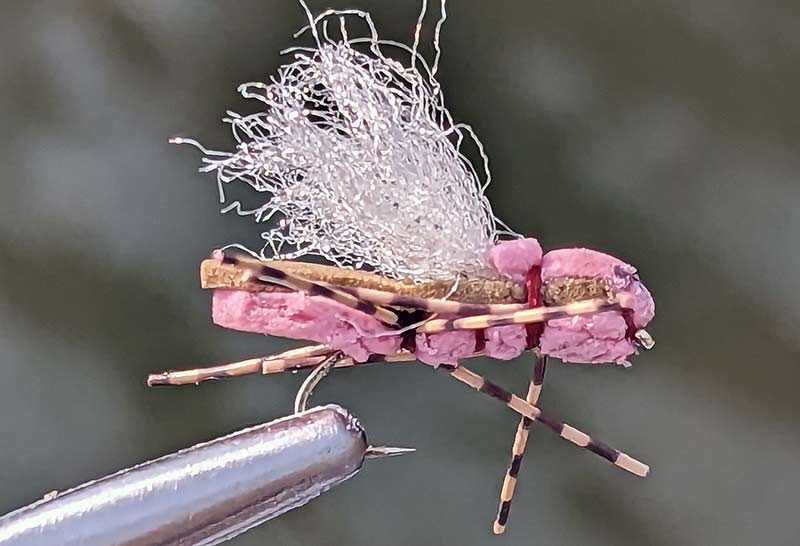
Last season’s top new fly was this updated version of my GFA hopper. More foam, more legs, and a white wing. The trout obviously approved!
Yellowstone Park Waters
- Firehole and Madison Rivers: Best from the season opener through June 15 and from September 15 until the roads close. No appeciable runoff. This water will be closed or should be from late June until Labor Day.
- Gibbon River (Below Norris): Best from the season opener through June 15, except possibly with a brief spot of dirty water between May 20 and the end of the month. Also good but not epic from September 15 until the roads close. This water will be closed or should be in July and August. Above Norris Geyser Basin, the Gibbon fishes like a small stream (see below).
- Gardner River: Best from June 15 through July 15, and from October 1 until the season ends. There will probably be sporadic periods of unfishable runoff in May and early June, but cool spells will drop the river back into shape throughout this period. Late-season fishing is almost always epic on this river.
- Yellowstone River (Grand Canyon): No or very brief unfishable runoff between May 20 and June 10 (if it stays clear, it will stay great). Great again from June 15 through July, but decent through September. Potential 2PM closures in late July and August. On sunny days in September, this will be our best trout fishery.
- Yellowstone River (Black Canyon): Runoff until June 10–15. Peak from June 20 through July 20. 2PM closures are likely in late July and August.
- Yellowstone River (Lake to Falls): Opens July 1 and likely as good as it ever gets for the three weeks thereafter.
- Slough Creek: Runoff ends June 15–20. Best from June 25 until July 20. Potential 2PM closures but likely very difficult fishing thereafter.
- Soda Butte Creek & Lamar River: Runoff ends June 20. Best from June 25 through July 25. Potential 2PM closures in late July and August. Fair but crowded fishing absent any closures.
- YNP Small Streams: Runoff ends June 5 to July 1, depending on the creek. Best for the month thereafter and very, very low in late summer. 2PM closures possible in late July and August.
- YNP Lakes: Best from ice-out (anywhere from May 1 to June 5, depending on the lake) for the month thereafter. Open but tough fishing from late July onward.
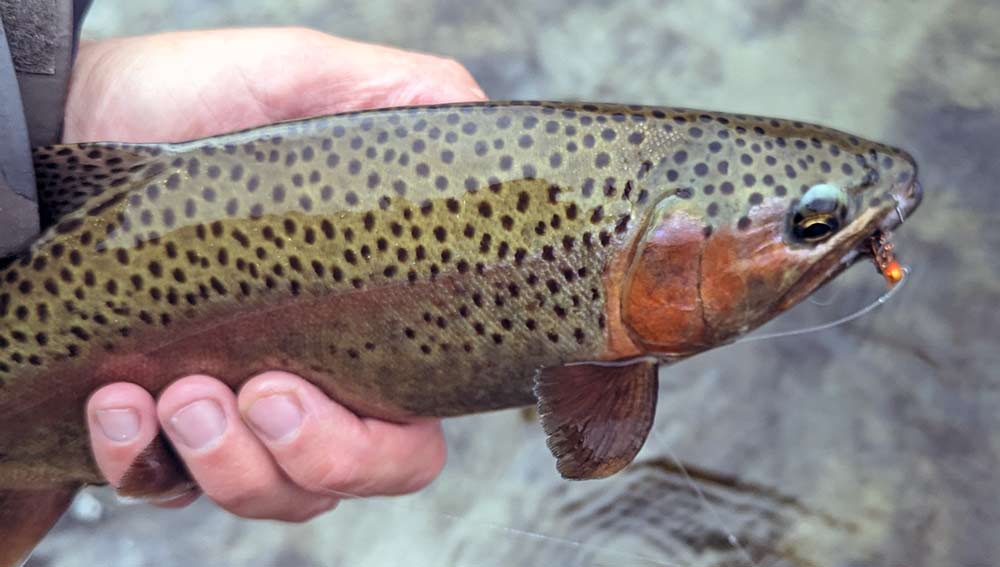
The late season is always great on the Gardner River. While I only caught a couple fall-run browns on this late October day, I landed 53 trout overall on my last day of the season on the Gardner, in only three hours. This rainbow was extra pretty, but otherwise not out of the ordinary.
The late season is always great on the Gardner River. While I only caught a couple fall-run browns on this late October day, I landed 53 trout overall on my last day of the season on the Gardner, in only three hours. This rainbow was extra pretty, but otherwise not out of the ordinary.
The Short Version
We are likely looking at extreme low snowpack and therefore extreme low water this season. While this will improve early summer fishing, it will hurt late summer and early autumn fishing.
In light of the above, I encourage clients planning trips this year to come during one of these three periods, if possible:
- In late March or especially April, before the spring melt.
- From mid-late June until roughly July 20
- As late in the fall as possible, preferably early October (for all fishing) or in October-November for wade-fishing.
We might be looking at tough fishing in late summer, or even widespread fishing closures. Early autumn won’t have the closures, but it will be very streaky. Cool, cloudy, smoky weather will be reasonably productive, but bright sun will make things tough.
Thanks for your business, and I hope to see you this (early) season.
I will post further snowpack and conditions updates beginning in a couple weeks.
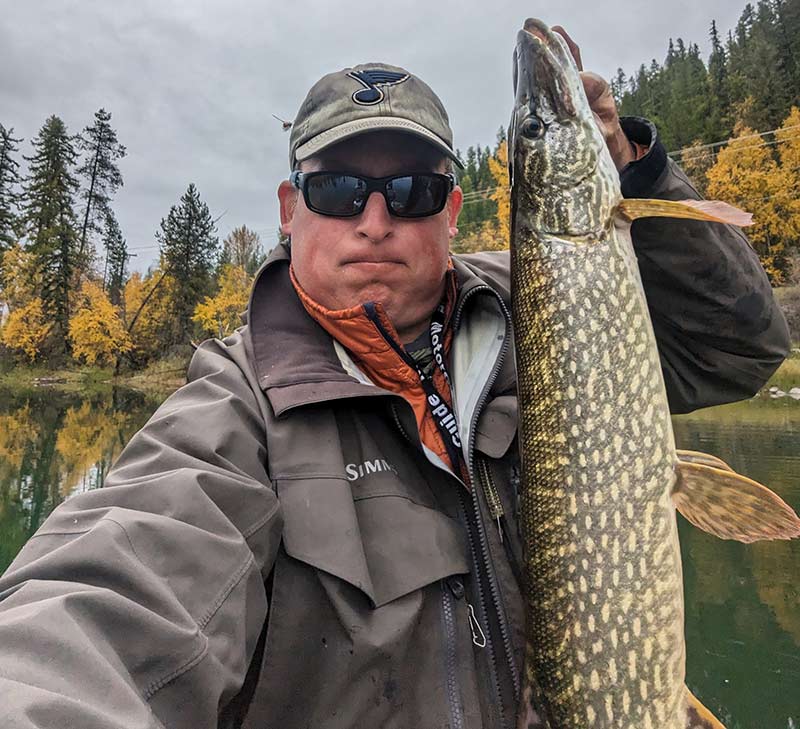
Nowhere near Yellowstone or Livingston, but an example of my latest obsession. I caught this one from the Swan River in northwest Montana.